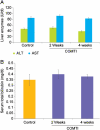Towards non-surgical therapy for uterine fibroids: catechol-O-methyl transferase inhibitor shrinks uterine fibroid lesions in the Eker rat model
- PMID: 21896544
- PMCID: PMC3196875
- DOI: 10.1093/humrep/der280
Towards non-surgical therapy for uterine fibroids: catechol-O-methyl transferase inhibitor shrinks uterine fibroid lesions in the Eker rat model
Abstract
Background: Uterine leiomyomas (fibroids) are the most common pelvic tumors in women. We assessed the potential therapeutic utility of Ro 41-0960, a synthetic catechol-O-methyl transferase inhibitor (COMTI), in the Eker rat.
Methods: We randomized uterine fibroid-bearing Eker rats for treatment with Ro 41-0960 (150 mg/kg/12 h) versus vehicle for 2 and 4 weeks. The fibroids were measured by caliper and subjected to histological evaluation. Urinary levels of 2-hydroxy estrogen (E(2)), 16-hydroxy E2 and DPD (osteoporosis marker) and serum liver enzymes were evaluated. Expressions of Cyclin D1, proliferating cell nuclear antigen (PCNA), Poly [ADP-ribose] polymerase1 (PARP1), tumor suppressor gene (P53) and transforming growth factor (TGFβ3) were assessed in fibroids using immunohistochemical analysis or RT-PCR. Apoptosis was confirmed using terminal deoxynucleotidyltransferase-mediated dUTP nick-end labeling (TUNEL).
Results: Ro 41-0960-treated rats exhibited fibroid volumes of 86 ± 7% and 105 ± 12% of initial burden, at 2 and 4 weeks post-treatment, respectively, significantly lower than control group (240 ± 15% and 300 ± 18%; P< 0.01). Ro 41-0960 increased the urinary 2-hydroxy E2/16-hydroxy E(2) ratio, level of p53 mRNA and TUNEL positivity (P< 0.05) and decreased PARP1, PCNA and cyclin D1 proteins and TGFβ3 mRNA (P< 0.05). Ro 41-0960 did not change normal tissue histology, liver functions or urinary DPD level.
Conclusions: Ro 41-0960 (COMTI) arrested growth/shrunk uterine fibroids in Eker rats. This result may be related to modulation of estrogen-dependent genes involved in apoptosis, proliferation and extracellular matrix deposition via accumulation of 2-hydroxy estrogen. The efficacy and safety of Ro 41-0960 in rats suggest its candidacy for treatment of uterine fibroids.
Figures







Similar articles
-
Gene therapy targeting leiomyoma: adenovirus-mediated delivery of dominant-negative estrogen receptor gene shrinks uterine tumors in Eker rat model.Fertil Steril. 2010 Jan;93(1):239-50. doi: 10.1016/j.fertnstert.2008.09.086. Epub 2009 Jan 14. Fertil Steril. 2010. PMID: 19144333 Free PMC article.
-
1,25-dihydroxyvitamin D3 treatment shrinks uterine leiomyoma tumors in the Eker rat model.Biol Reprod. 2012 Apr 19;86(4):116. doi: 10.1095/biolreprod.111.098145. Print 2012 Apr. Biol Reprod. 2012. PMID: 22302692 Free PMC article.
-
Towards fibroid gene therapy: adenovirus-mediated delivery of herpes simplex virus 1 thymidine kinase gene/ganciclovir shrinks uterine leiomyoma in the Eker rat model.Gynecol Obstet Invest. 2009;68(1):19-32. doi: 10.1159/000209675. Epub 2009 Mar 27. Gynecol Obstet Invest. 2009. PMID: 19325244 Free PMC article.
-
Epidemiological and genetic clues for molecular mechanisms involved in uterine leiomyoma development and growth.Hum Reprod Update. 2015 Sep-Oct;21(5):593-615. doi: 10.1093/humupd/dmv030. Epub 2015 Jul 3. Hum Reprod Update. 2015. PMID: 26141720 Free PMC article. Review.
-
Ulipristal acetate for uterine fibroid-related symptoms.Drugs Today (Barc). 2015 Nov;51(11):661-7. doi: 10.1358/dot.2015.51.11.2413469. Drugs Today (Barc). 2015. PMID: 26744741 Review.
Cited by
-
Association of three single nucleotide polymorphisms of ESR1with breast cancer susceptibility: a meta-analysis.J Biomed Res. 2017 Jan 19;31(3):213-225. doi: 10.7555/JBR.31.20160087. J Biomed Res. 2017. PMID: 28808214 Free PMC article.
-
Proceedings from the Third National Institutes of Health International Congress on Advances in Uterine Leiomyoma Research: comprehensive review, conference summary and future recommendations.Hum Reprod Update. 2014 May-Jun;20(3):309-33. doi: 10.1093/humupd/dmt058. Epub 2014 Jan 8. Hum Reprod Update. 2014. PMID: 24401287 Free PMC article.
-
Association of five single nucleotide polymorphisms at 6q25.1 with breast cancer risk in northwestern China.Am J Cancer Res. 2015 Jul 15;5(8):2467-75. eCollection 2015. Am J Cancer Res. 2015. PMID: 26396922 Free PMC article.
-
Racial and ethnic differences in the pathogenesis and clinical manifestations of uterine leiomyoma.Semin Reprod Med. 2013 Sep;31(5):370-9. doi: 10.1055/s-0033-1348896. Epub 2013 Aug 9. Semin Reprod Med. 2013. PMID: 23934698 Free PMC article.
-
Alternative Oral Agents in Prophylaxis and Therapy of Uterine Fibroids-An Up-to-Date Review.Int J Mol Sci. 2017 Dec 1;18(12):2586. doi: 10.3390/ijms18122586. Int J Mol Sci. 2017. PMID: 29194370 Free PMC article. Review.
References
-
- Acil Y, Brinckman J, Nothbohm H, Muller K, Batge B. Changes with age in the urinary excretion of hydroxylysylpyridinoline (HP) and lysylpyridinoline (LP) Scand J Clin Lab Invest. 1996;56:275–283. doi:10.3109/00365519609088617. - DOI - PubMed
-
- Ahsan H, Chen Y, Whittemore AS, Kibriya MG, Gurvich I, Senie RT, Santella RM. A family-based genetic association study of variants in estrogen-metabolism genes COMT and CYP1B1 and breast cancer risk. Breast Cancer Res Treat. 2004;85:121–131. doi:10.1023/B:BREA.0000025401.60794.68. - DOI - PubMed
-
- Al-Hendy A, Salama S. Gene therapy and uterine leiomyoma: a review. Hum Reprod Update. 2006a;16:385–400. doi:10.1093/humupd/dml015. - DOI - PubMed
-
- Al-Hendy A, Salama SA. Ethnic distribution of estrogen receptor-alpha polymorphism is associated with a higher prevalence of uterine leiomyomas in black Americans. Fertil Steril. 2006b;86:686–693. doi:10.1016/j.fertnstert.2006.01.052. - DOI - PubMed
-
- Al-Hendy A, Lee EJ, Wang HQ, Copland JA. Gene therapy of uterine leiomyomas: adenovirus-mediated expression of dominant negative estrogen receptor inhibits tumor growth in nude mice. Am J Obstet Gynecol. 2004;191:1621–1631. doi:10.1016/j.ajog.2004.04.022. - DOI - PubMed
Publication types
MeSH terms
Substances
Grants and funding
LinkOut - more resources
Full Text Sources
Molecular Biology Databases
Research Materials
Miscellaneous

